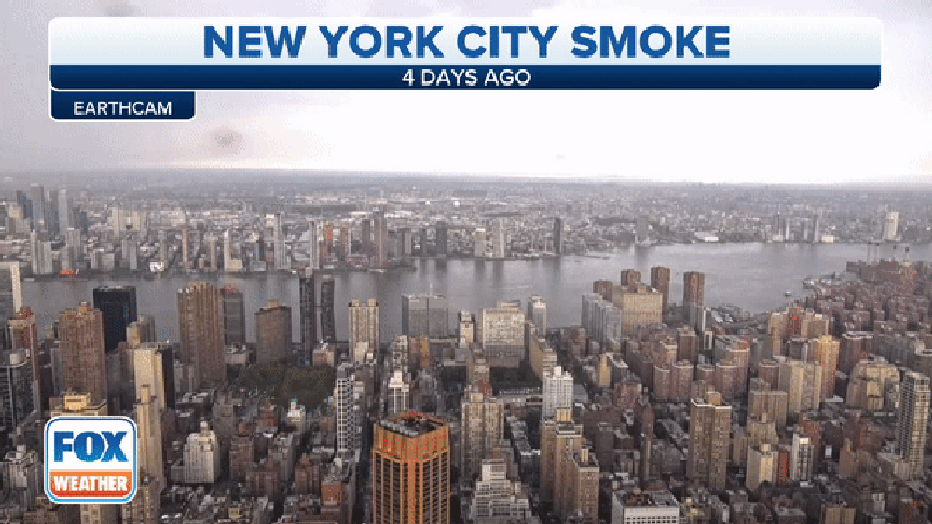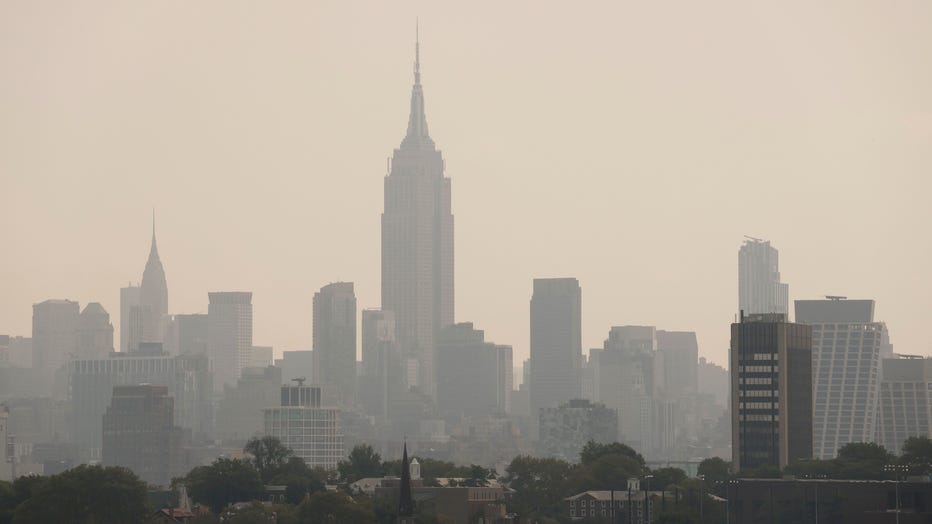Canada's supercharged wildfire forecast could mean bad air quality in US through fall
Canadian officials released a sobering wildfire activity forecast through the fall. The news could have residents of the northern tier states gasping, literally. Meteorologists and fire weather experts put central Canada in "well above average" wildfire activity.
As we have seen through the summer, wildfire smoke drifts into the U.S. and oftentimes knocks air quality for millions down to unhealthy.
THE AIR QUALITY INDEX EXPLAINED: WHAT AIR QUALITY IS BAD?

File: New York City on June 3 then on June 7, 2023, after smoke from Canada's wildfires invaded. (FOX Weather / FOX Weather)
"Predictions for ongoing warm and dry weather may contribute to new fire starts, and there remains a likelihood that some existing large fires may continue to be active through September and possibly later into fall or winter," National Resources Canada said in a statement.
The fire forecast is based on drought conditions and temperature and precipitation forecasts, according to National Resources Canada.
WHAT IS AN AIR QUALITY ACTION DAY?
That could mean more air quality alerts like the ones across six states last week. It could also mean more blood-red, smokey sunsets that we saw in New York in June through Halloween. A health professional told FOX Weather that 15 minutes of breathing outside during New York City's June air quality emergency was the equivalent of smoking half a pack of cigarettes.
"Canada's worst wildfire season"
The Minister of Energy and Natural Resources called 2023 "Canada's worst wildfire season."
"This year’s wildfire season has been unprecedented and devastating for communities across the country," said the Minister of Employment, Workforce Development and Official Languages in a statement. "Evacuations have disrupted the lives of tens of thousands of Canadians."
So far, over 42 million acres have burned across Canada. The Canadian Interagency Forest Fire Centre reports that 925 fires are currently burning, and 560 of them are out of control. Year to date, 6,208 fires have ignited across the country.
The number of wildfires is above normal, but the intensity and areal extent make this fire season unprecedented, according to Canadian officials. The burned area would encompass all of Rhode Island, Delaware, Connecticut, New Jersey, New Hampshire, Vermont, Massachusetts, Maryland, and Washington D.C.
The past nine years combined total 40 million acres. On average, the country only sees 5.7 million acres burned annually.
To put this in perspective, the U.S.'s worst fire year in the past 40 years was 2015, when 10.1 million acres burned.
Smoke can create health hazards

Haze caused by smoke from wildfires in Canada shrouds the skyline of midtown Manhattan and the Empire State Building in New York City behind the city of Hoboken, New Jersey on July 18, 2023, as seen from Jersey City, New Jersey. (Photo by Gary Hersho
From itchy eyes to shortness of breath to complicating pre-existing conditions, such as asthma and emphysema, a number of symptoms may come from particulates in wildfire smoke. The particulates can lodge into your airways and cause chronic inflammation and chronic shortness of breath, said Dr. Sampson Davis, CareWell emergency medicine physician.
"Fine particle pollution from wildfire smoke can irritate eyes, nose, and throat and cause coughing, chest tightness, shortness of breath, dizziness, or fatigue," warns the Minnesota Pollution Control Agency.
WILDFIRES CAN BE DANGEROUS TO YOUR HEALTH EVEN IF YOU ARE NOWHERE NEAR ONE
"Smoke particles are small enough that they can be breathed deeply into lungs and enter the bloodstream. This can lead to illnesses such as bronchitis or aggravate existing chronic heart and lung diseases, triggering heart palpitations, asthma attacks, heart attacks, and strokes," the agency's statement continued.
Smoke can travel thousands of miles through the atmosphere. So even if you, your family and pets are not close to a wildfire, the air quality could be compromised. In June, the Copernicus Atmosphere Monitoring Service found Canadian wildfire smoke drifting to Europe.
CAMS maps forecast where the smoke will travel based on weather models. Here is the forecast.
FOX Weather monitors air quality across the U.S. Check here for conditions near you.

